112/3/D3
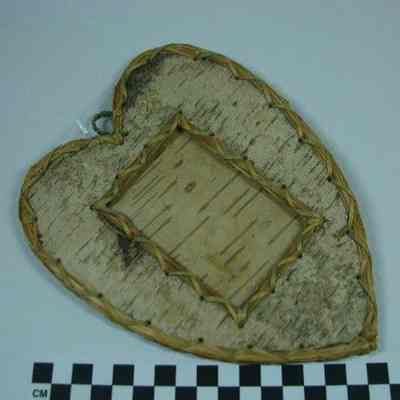
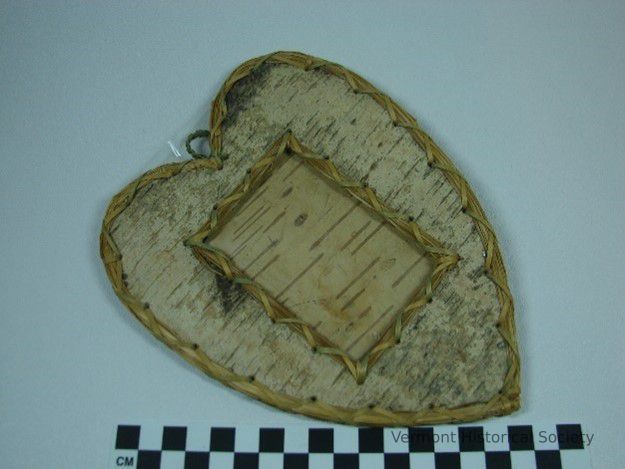
Birch Bark Picture Frame
Name/Title
Birch Bark Picture Frame
Lexicon
Description
Heart-shaped, birch bark object with square void in the middle. Two layers of birch bark stitched together with wood splint binding.
Use
Picture frame
Acquisition
Source (if not Accessioned)
Abenaki Cultural Conservancy
Ethnography
Made/Created
Date made
circa 1920
Materials
Material
Birch
Entry/Object ID
L2024.3.117
Context
This piece of tourist art is probably a minor art form from the Highgate Springs Indian basket camps three miles to the south in the USA, since it employs both ash splint sewing and sweetgrass borders. The idea is that a photograph can be slid between the bark front and back and show in the ash and sweetgrass rimed window. It is one of the few examples of birchbark work that shows the white outside of the bark, probably catering to the tourists’ need to have something “woodsy” hanging on the wall.
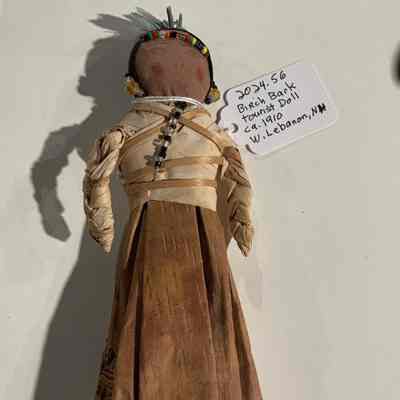
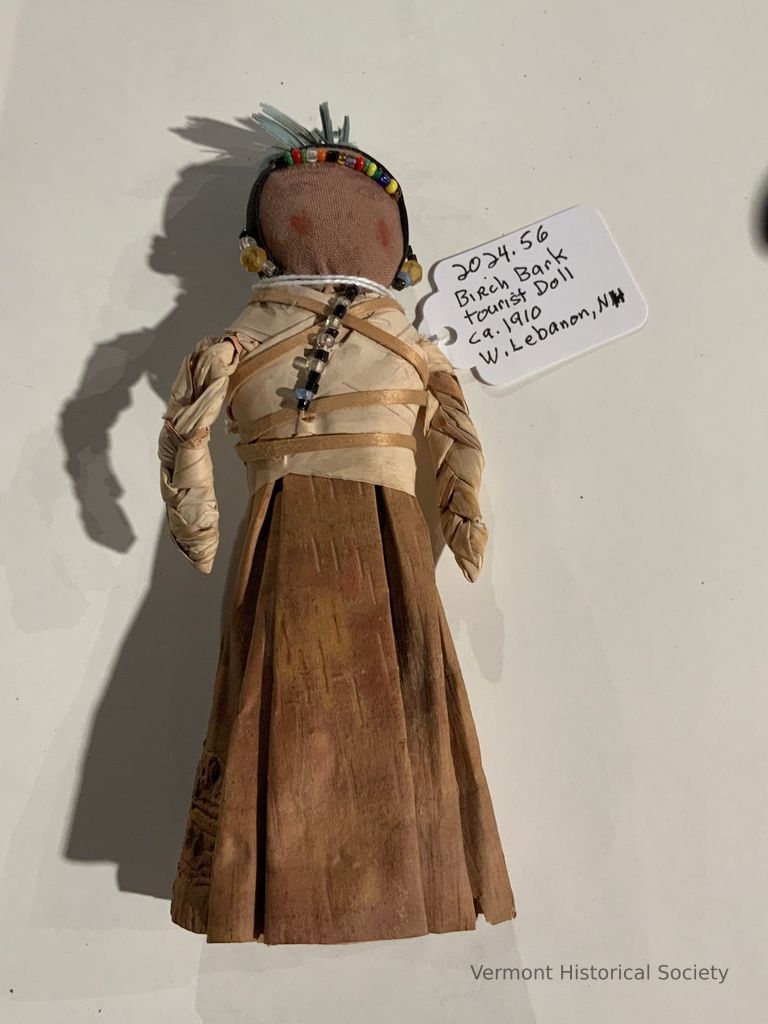
Birchbark Doll
Name/Title
Birchbark Doll
Lexicon
Description
Birchbark doll
Acquisition
Source (if not Accessioned)
Abenaki Cultural Conservancy
Made/Created
Date made
circa 1910
Entry/Object ID
L2024.3.56
Context
For the tourist trade

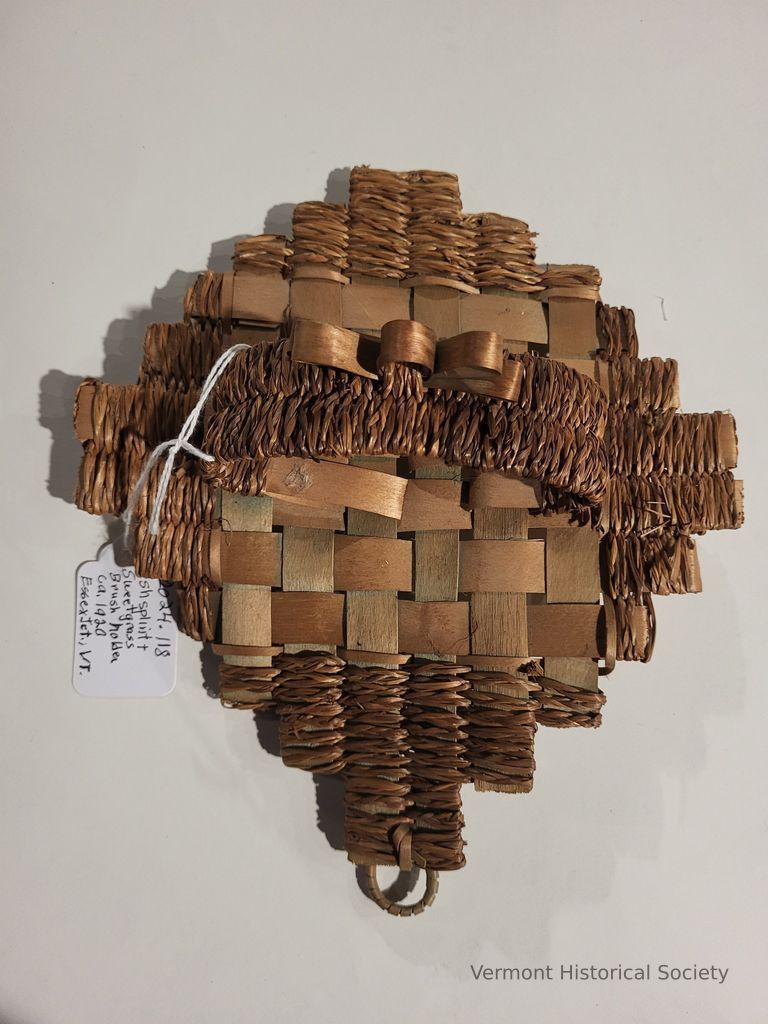
Brush Holder
Name/Title
Brush Holder
Lexicon
Description
Ash splint and sweetgrass basket
Use
Brush holder
Acquisition
Source (if not Accessioned)
Abenaki Cultural Conservancy
Ethnography
Made/Created
Date made
circa 1920
Materials
Material
Ash Splint, Sweetgrass
Entry/Object ID
L2024.3.118
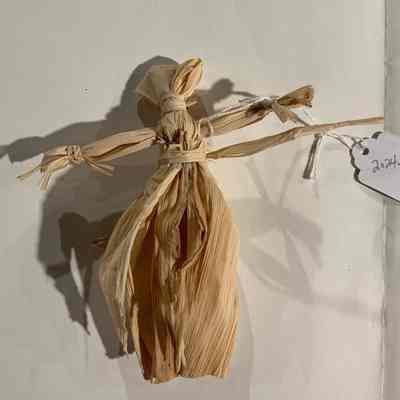
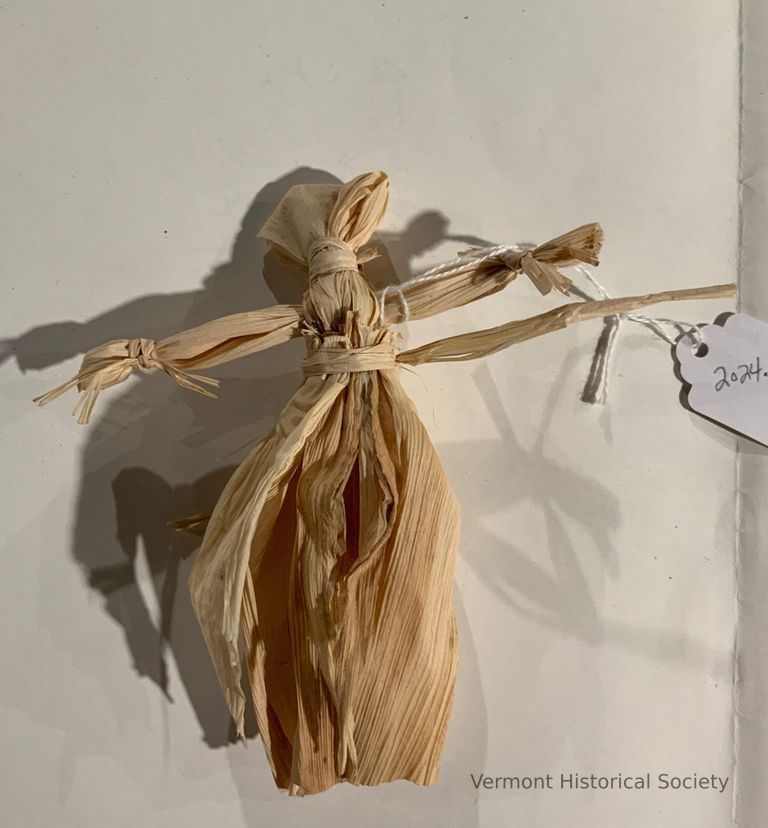
Cornhusk Doll
Name/Title
Cornhusk Doll
Lexicon
Description
Cornhusk “sprite” doll made by Peggy Fullerton of Piermont, NH
Acquisition
Source (if not Accessioned)
Abenaki Cultural Conservancy
Ethnography
Made/Created
Artist Information
Fullerton, Peggy
Artist
Date made
circa 2002
Entry/Object ID
L2024.3.207
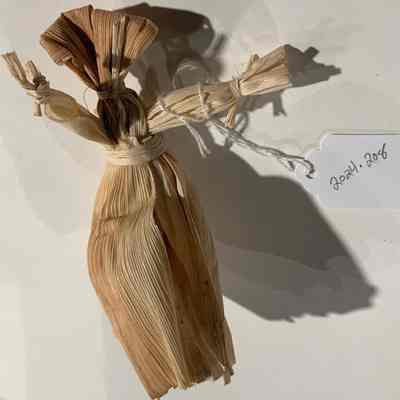

Cornhusk doll
Name/Title
Cornhusk doll
Lexicon
Description
Cornhusk “sprite” doll made by Peggy Fullerton of Piermont, NH
Acquisition
Source (if not Accessioned)
Abenaki Cultural Conservancy
Ethnography
Made/Created
Artist Information
Fullerton, Peggy
Artist
Date made
circa 2002
Materials
Material
Cornhusk
Entry/Object ID
L2024.3.208
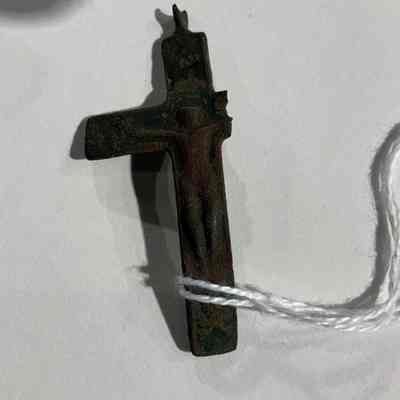
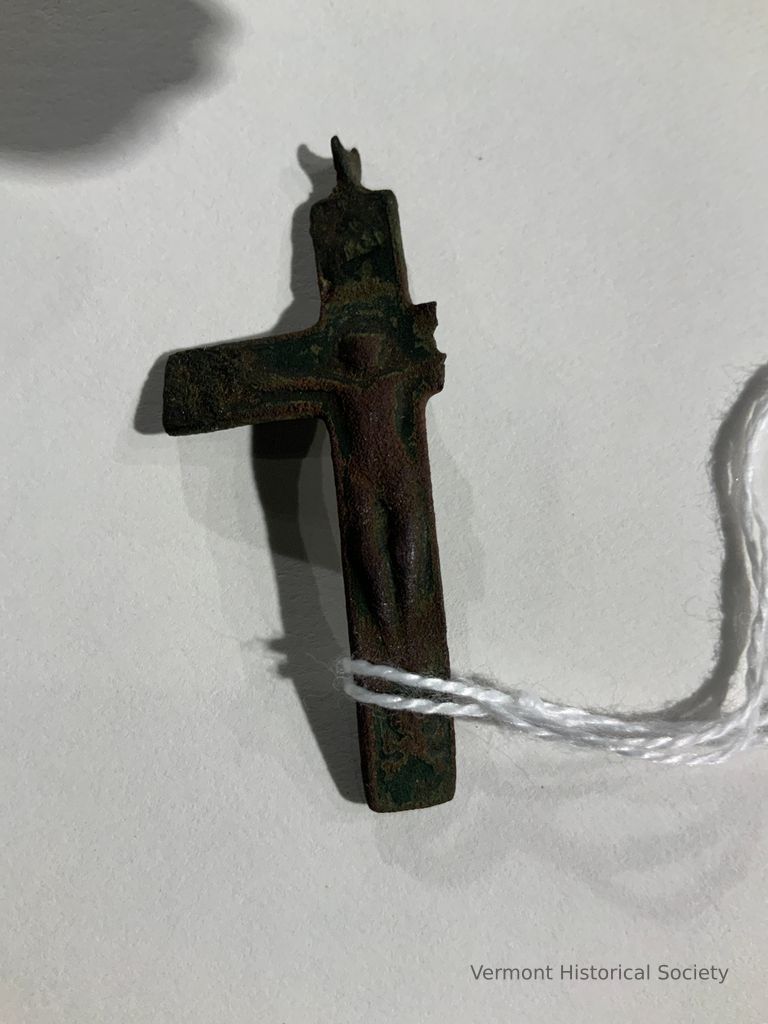
Cross Pendant
Name/Title
Cross Pendant
Item Type
Lexicon
Description
"Jesuit" cross
Acquisition
Source (if not Accessioned)
Abenaki Cultural Conservancy
Made/Created
Date made
circa 1650-circa 1720
Materials
Material
Silver
Entry/Object ID
L2024.3.38
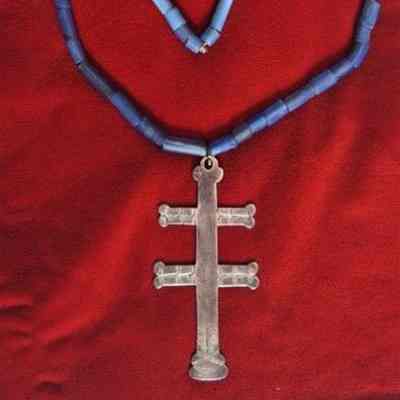
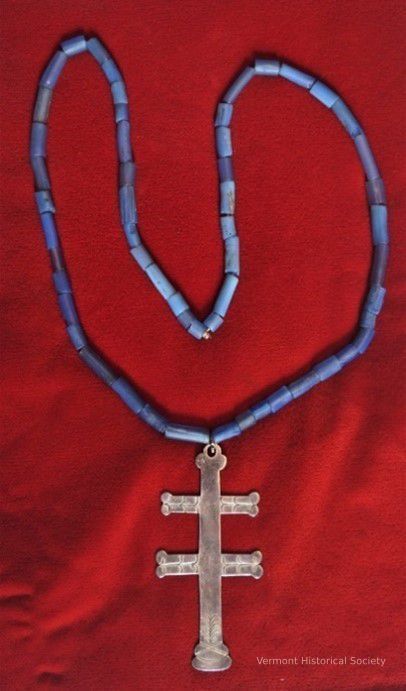
Cross Pendant
Name/Title
Cross Pendant
Item Type
Lexicon
Description
Silver cross in "Montreal" style with modern beaded chain. Silver cross has two sets of arms, both terminating in two lobes. Top of cross has three lobes with the middle lobe pierced. Foot of cross has a single lobe. Engraved floral design on arms and lower portion near foot.
Use
Used in Central Vermont
Made/Created
Date made
circa 1780
Materials
Material
Silver
Entry/Object ID
L2024.3.37
Context
The Montreal cross from a family with Native ancestry was shared with the old Abenaki Research Project as proof of a native lineage. The ancestral line traces to Franklin County, VT. It is a classic example of a silver pendant, believed to represent the dragonfly to some native peoples. This example is beautifully crafted of thick silver sheet with minimal incising on the arms and base. It is unmarked. It is suspended from a coeval string of blue glass tubular beads but has been restrung on artificial sinew.
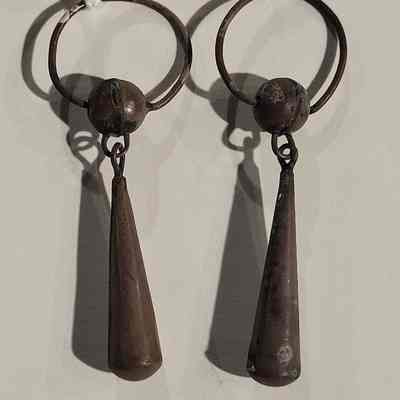

Earbob
Name/Title
Earbob
Item Type
Lexicon
Description
pair of ball and cone earings
Acquisition
Source (if not Accessioned)
Abenaki Cultural Conservancy
Relationships
Related Person or Organization
Gravel, Benjamin Frederick (1895-1988)
Person or Organization
Made/Created
Date made
circa 1780
Materials
Material
Silver
Entry/Object ID
L2024.3.9a-b
Context
These little silver “ball and cone” earbobs were ubiquitous in Native America in the late 18th and early 19th centuries. There is one other published ball and cone earbob set from Vermont, so they are not unique. Also, earbob fragments from pairs like these have been found before in burial contexts in Vermont. Ex Ben Gravel Collection. I distinctly remember him once telling me that they style was “Probably from Central New Hampshire,” but elsewhere he said they were from Vermont. Both Vermont and New Hampshire are American Abenaki territory, so the ambiguity is annoying but not politically significant.
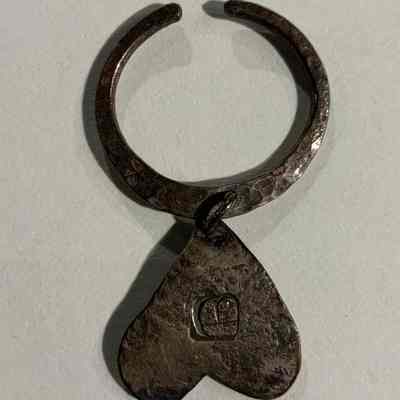
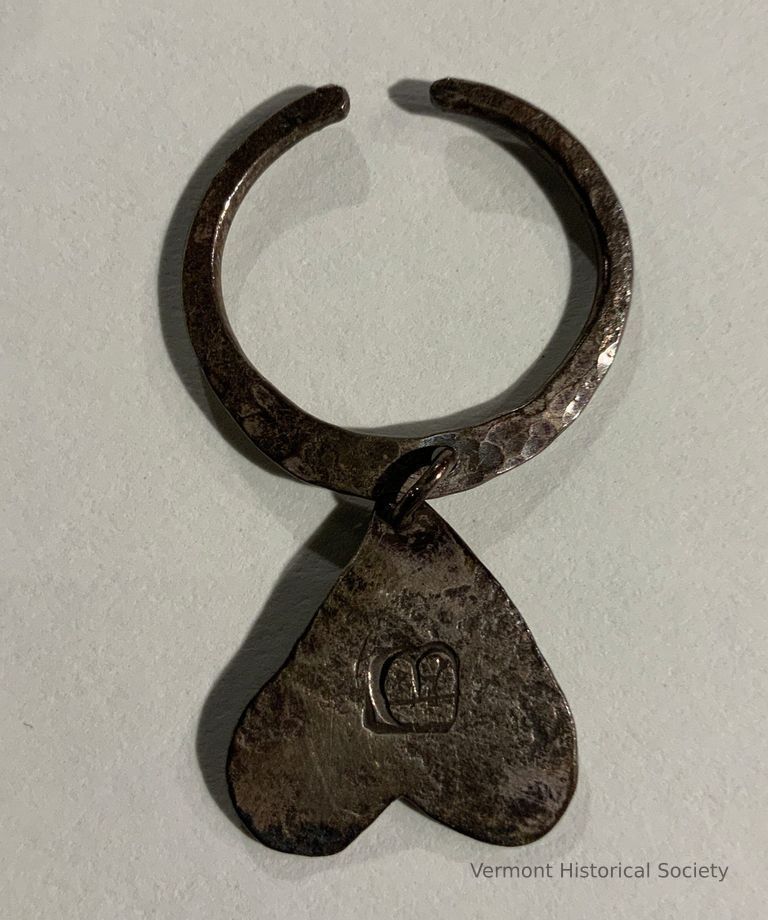
Earring
Name/Title
Earring
Item Type
Lexicon
Description
Ear or nose bob
Use
Ear or nose decoration
Acquisition
Source (if not Accessioned)
Abenaki Cultural Conservancy
Made/Created
Date made
circa 1780
Materials
Material
Silver
Entry/Object ID
L2024.3.28
Context
This tiny ear or nose bob has a flattened split ring to engage the flesh, so it was probably not designed be worn with a piercing
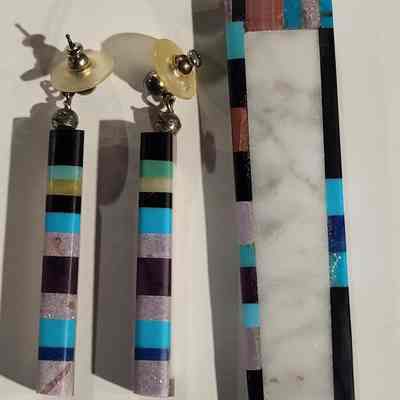
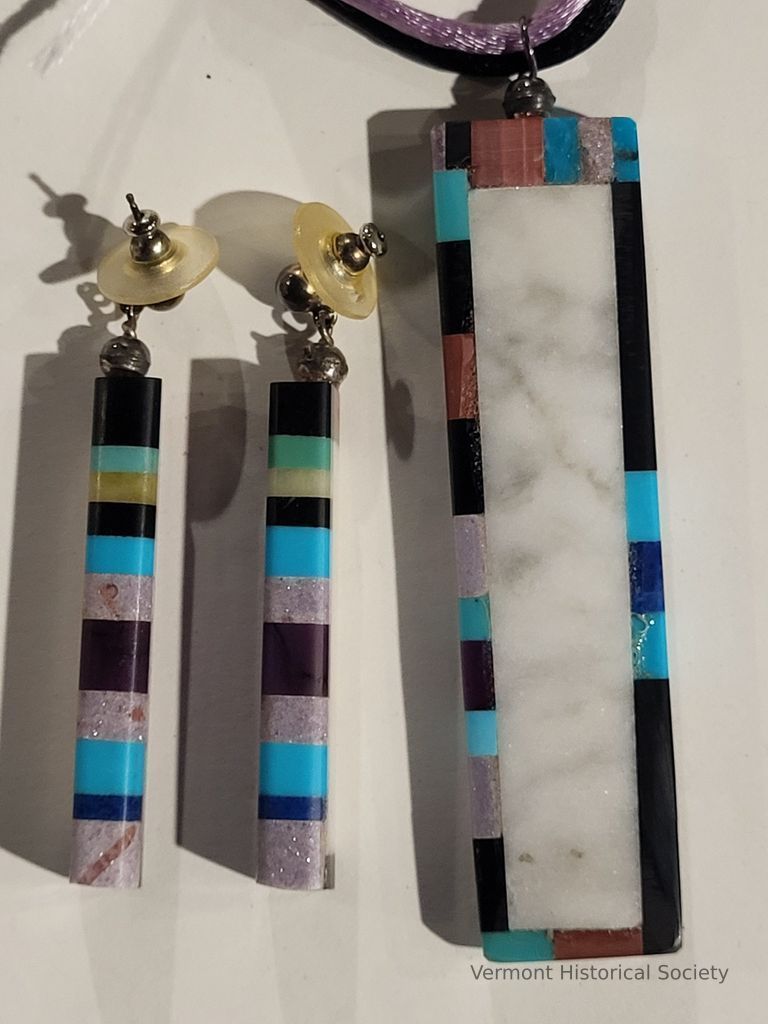
Earring and Pendant Set
Name/Title
Earring and Pendant Set
Lexicon
Description
Earring and pendant set made from fluorite and other semi-precious stones. Pendant is rectangular in shape with a large white/beige stone in the center surrounded by alternating stones in red, blue, pink, and black. Pendant is suspended on a double cord of pink and black. Earrings are columnar in shape and consist of alternating bands of stone in red, blue, pink, yellow, and black. The set includes a velvet bag and original box.
Acquisition
Source (if not Accessioned)
Abenaki Cultural Conservancy
Made/Created
Artist Information
Tsonakwa, Gerard Rancourt
Artist
Date made
1989
Entry/Object ID
L2024.3.86a-e
Web Links and URLs
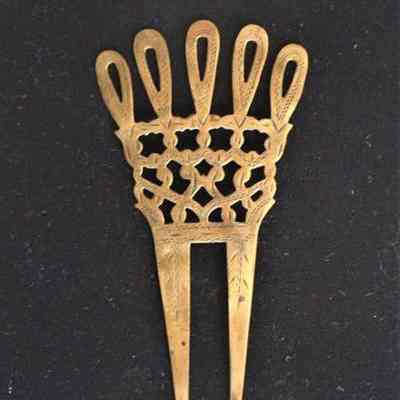
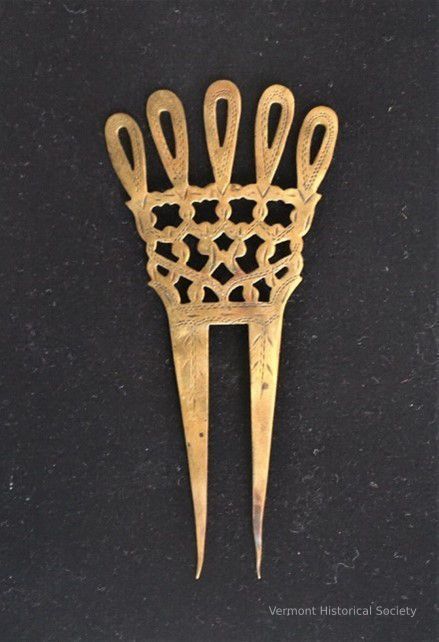
Hair Ornament
Name/Title
Hair Ornament
Item Type
Lexicon
Description
Wedge-shaped, brass woman's hair ornament with two arms at the base to form the comb with an upper, pierced decoration reminiscent of knotted rope. Crest of the piece has five loops. Surface is engraved with simple decoration.
Acquisition
Source (if not Accessioned)
Abenaki Cultural Conservancy
Made/Created
Date made
circa 1780
Materials
Material
Brass
Entry/Object ID
L2024.3.22
Context
This exquisite, engraved brass comb from Western Maine was a descendent of the common bone and ivory hair ornaments used by Native women all over New England.
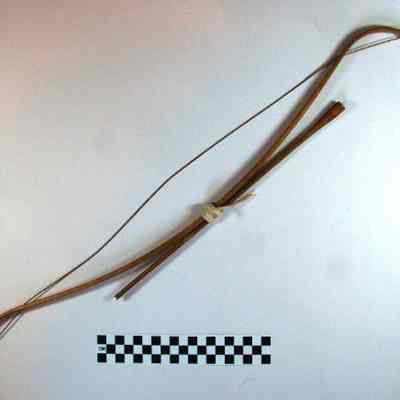
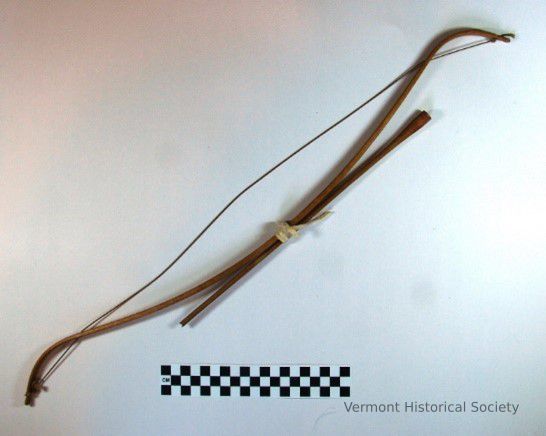
Miniature Bow and Arrow Set
Name/Title
Miniature Bow and Arrow Set
Lexicon
Description
Miniature recurve bow with string through stave and waterfowl arrow. Arrow is tied to stave with strip of fabric.
Acquisition
Source (if not Accessioned)
Abenaki Cultural Conservancy
Ethnography
Made/Created
Date made
circa 1900
Entry/Object ID
L2024.3.72a-b
Context
Made for the tourist trade
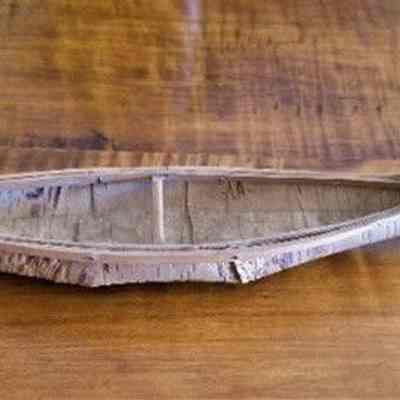
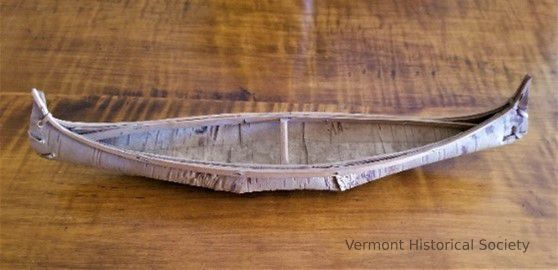
Miniature Canoe
Name/Title
Miniature Canoe
Lexicon
Description
Wood and birch bark canoe
Use
Model sold for the tourist trade
Acquisition
Source (if not Accessioned)
Abenaki Cultural Conservancy
Made/Created
Date made
circa 1930
Entry/Object ID
L2024.3.54
Context
This small canoe from Western New Hampshire is almost identical in construction to the common “Odanak Abenaki” model canoes sold by the ten thousand all over the Northeast and are still being made to this day. However, this one lacks the decking that is characteristic of the Odanak style that makes them almost look like a kayak. It is unclear whether this is an earlier, American Abenaki style, or a geographic variation, even if there are any others made in this style.
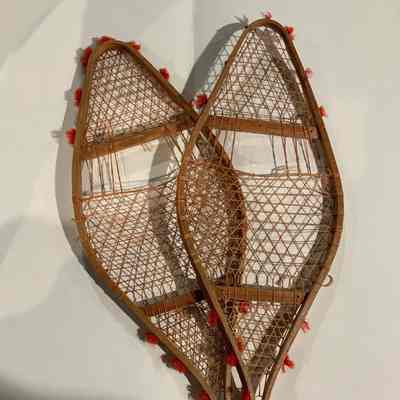
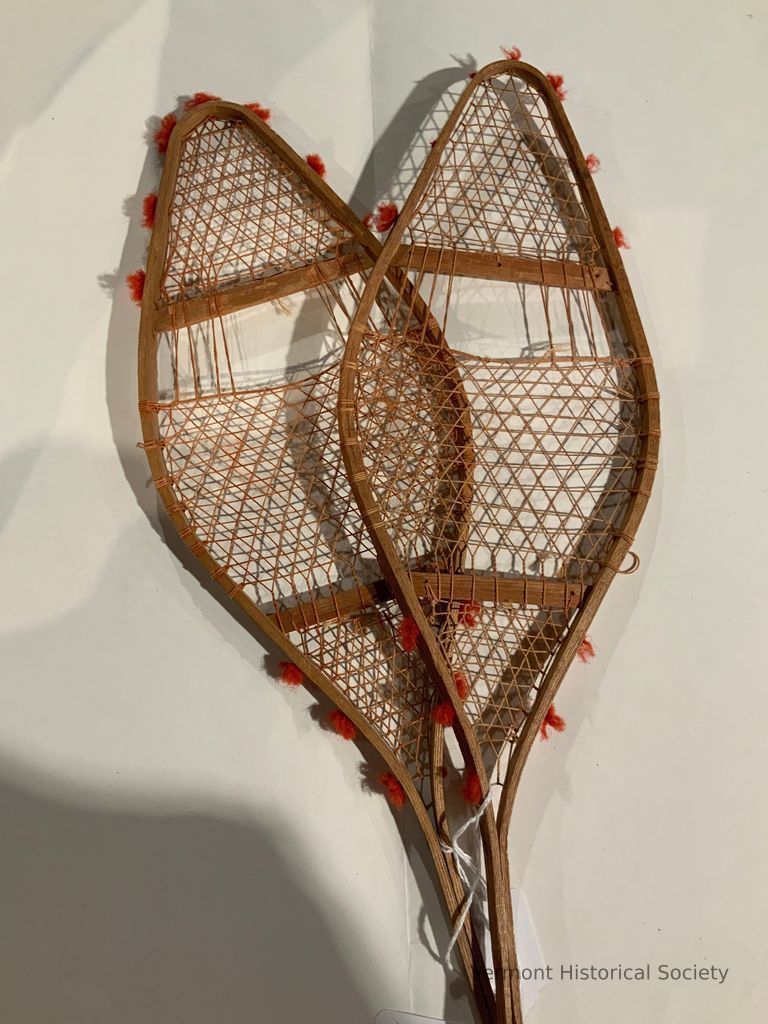
Miniature Snowshoes
Name/Title
Miniature Snowshoes
Lexicon
Description
wood and sinew snowshoes
Use
model snowshoes produced for the tourist trade
Acquisition
Source (if not Accessioned)
Abenaki Cultural Conservancy
Made/Created
Date made
circa 1930
Entry/Object ID
L2024.3.53a-b
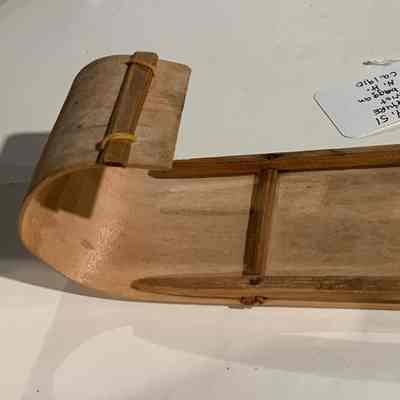

Miniature Toboggan
Name/Title
Miniature Toboggan
Lexicon
Use
Model made for tourist sale
Acquisition
Source (if not Accessioned)
Abenaki Cultural Conservancy
Made/Created
Date made
circa 1910
Entry/Object ID
L2024.3.51

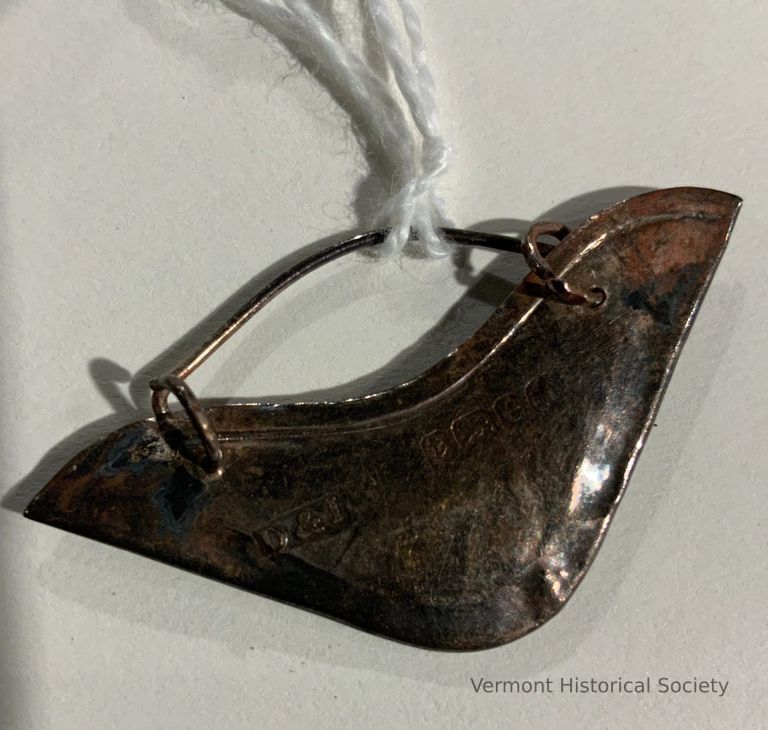
Nose Bob
Name/Title
Nose Bob
Item Type
Lexicon
Description
silver, wing-shaped nose bob with British hallmarks. Wire added in 1995.
Acquisition
Source (if not Accessioned)
Abenaki Cultural Conservancy
Made/Created
Date made
circa 1800
Materials
Material
Silver
Entry/Object ID
L2024.3.30
Context
This little piece of silver is a real anomaly. This nose ornament was designed to hang from a wire or sinew thread from a pierced nose septum. This is a hallmarked British piece made in 1812 and may have been manufactured as another item before being formed into jewelry. Wiseman states: If early VT racism was as strong as we tend to believe, it is hard to imagine a Vermont Indigenous person feeling safe enough to wear this obvious sign of Native identity in early 19th century Vermont. I believe that the only possibility would be well-known “old Indians” who were seen as colorful characters in many early 19th century Northern New England towns. This may have been an early 19th century gift to one of these men.
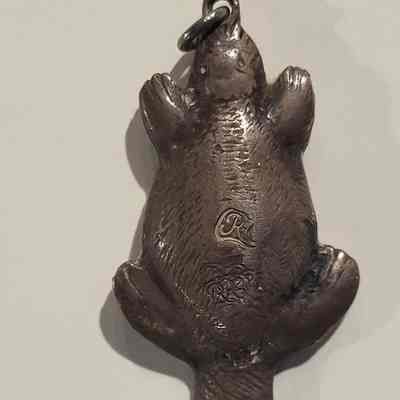
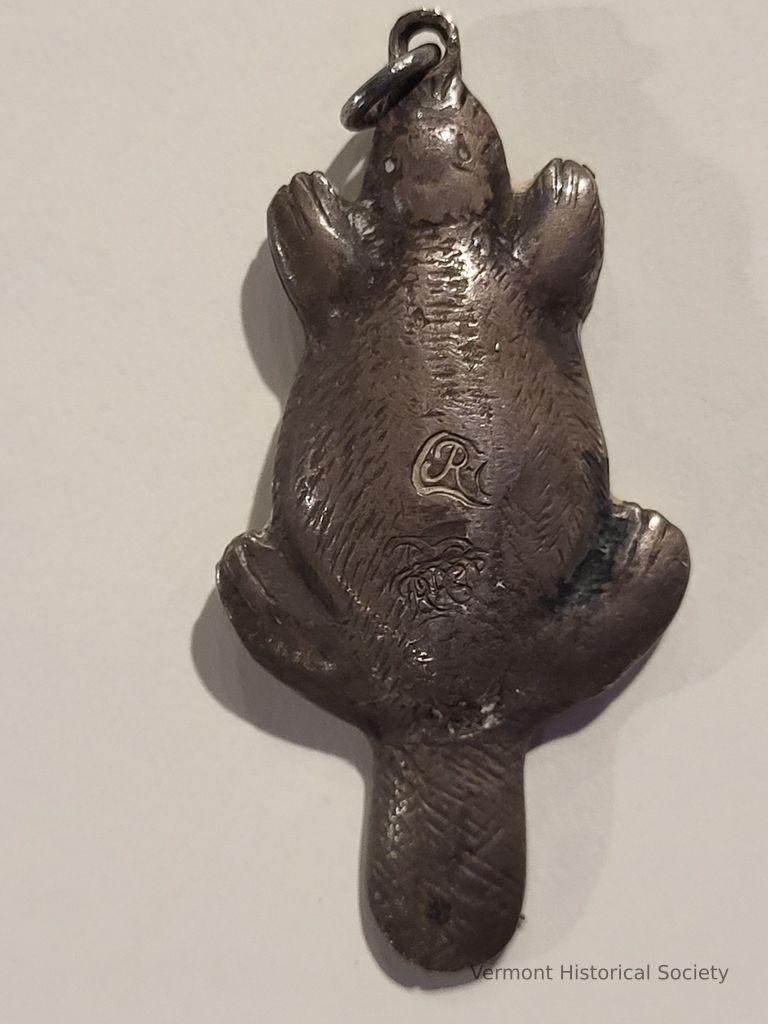
Pendant
Name/Title
Pendant
Item Type
Lexicon
Description
Beaver-shaped silver pendant
Acquisition
Source (if not Accessioned)
Abenaki Cultural Conservancy
Made/Created
Artist Information
Robert Cruickshank (c. 1748-1806)
Artist
Metal Smith
Role
Date made
circa 1780
Entry/Object ID
L2024.3.10
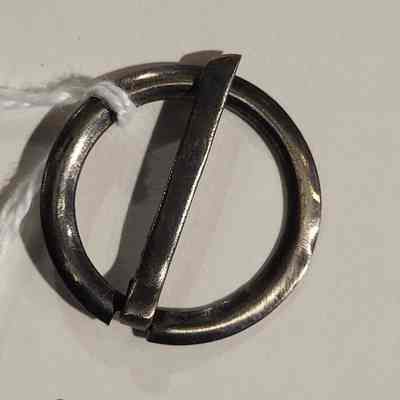
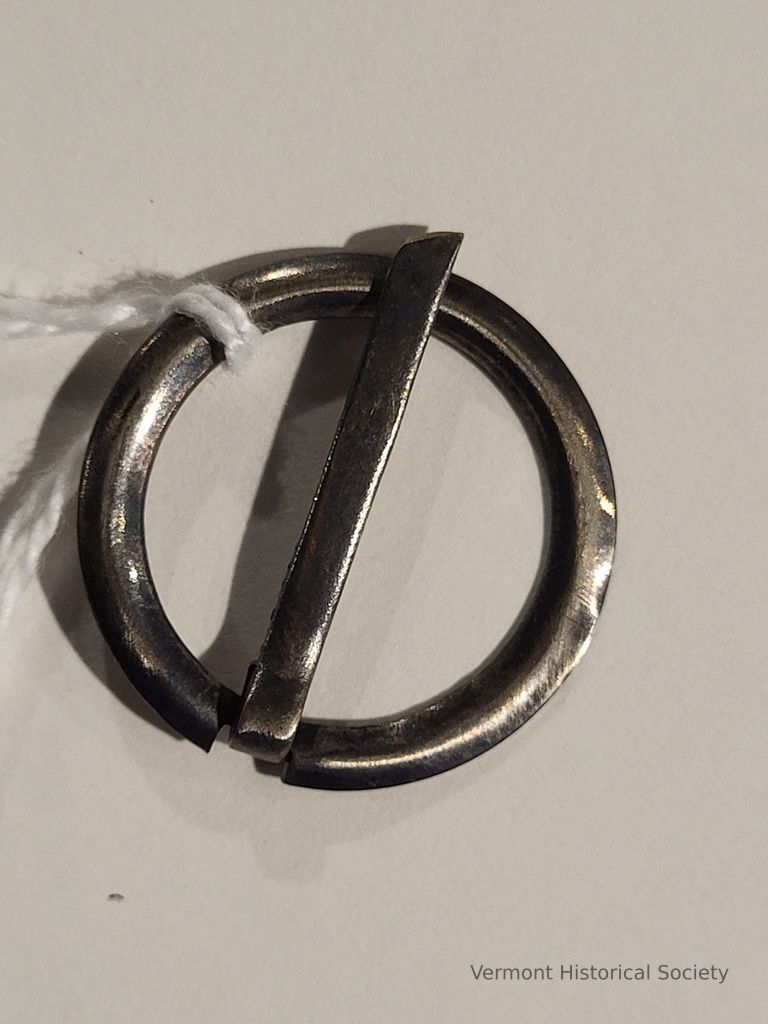
Ring Brooch
Name/Title
Ring Brooch
Lexicon
Description
Ring brooch
Acquisition
Source (if not Accessioned)
Abenaki Cultural Conservancy
Made/Created
Date made
circa 1800
Materials
Material
Silver
Entry/Object ID
L2024.3.5
Context
Wiseman states: This brooch, along with L2024.3.4 and L2024.3.6-8, were found in a Riker mount in the group shop, with a Western NH provenance and an assurance that they were solid coin silver and old. They were in almost pristine condition without much if any crinkling of the central prong. I worry that they were good repros, but they are not embossed “India” like many modern reproductions. They were full price, so I bought them for the provenance, but am unsure of their age, since trade silver is not my specialty.

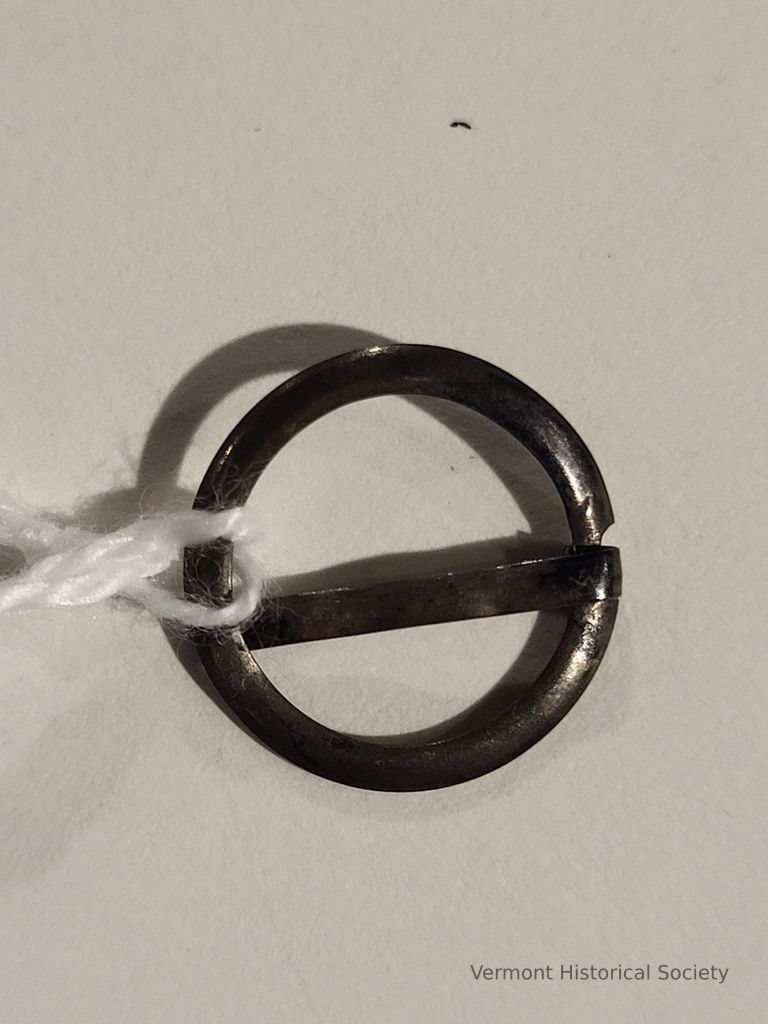
Ring Brooch
Name/Title
Ring Brooch
Item Type
Lexicon
Description
Small ring brooch
Acquisition
Source (if not Accessioned)
Abenaki Cultural Conservancy
Made/Created
Date made
circa 1800
Materials
Material
Silver
Entry/Object ID
L2024.3.2
Context
Wiseman states: as far as I know these three tiny, stamped ring brooches have not been reproduced for the reenactor trade. I purchased them from a reputable dealer who said in post purchased correspondence that they had a Salmon (Falls) River Valley (Border of Maine and NH) provenance and were found with some other 18th century personal items in an old house but would not give me the village they came from. They are in almost pristine condition.

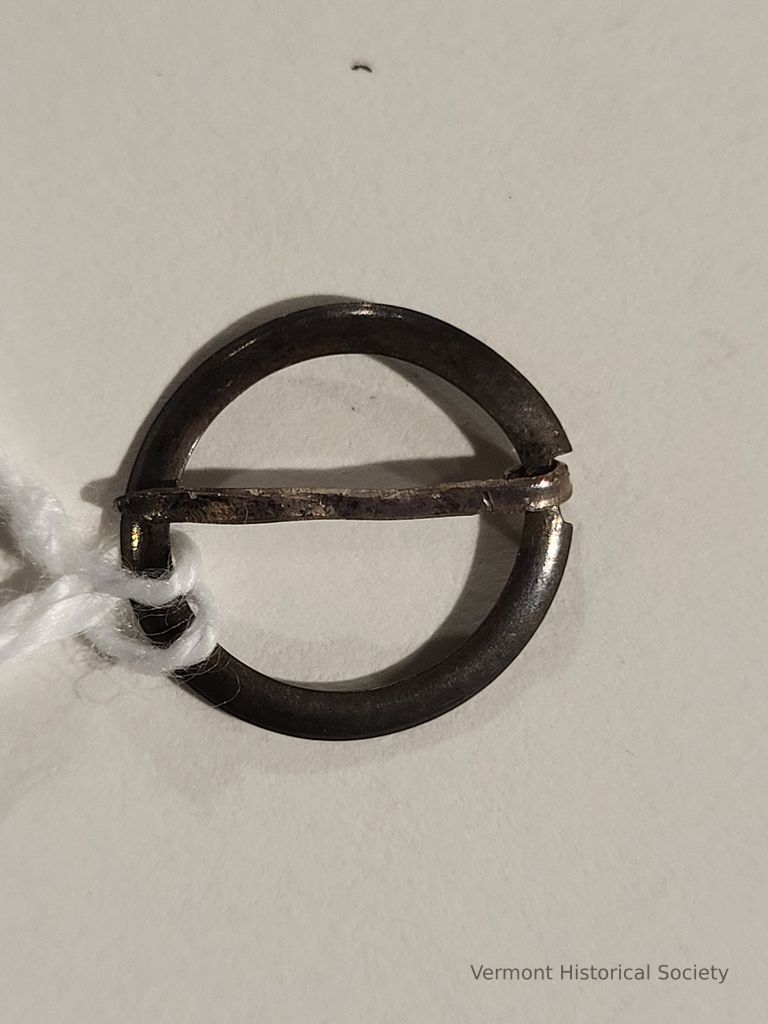
Ring Brooch
Name/Title
Ring Brooch
Item Type
Lexicon
Description
Small ring brooch
Acquisition
Source (if not Accessioned)
Abenaki Cultural Conservancy
Made/Created
Date made
circa 1800
Materials
Material
Silver
Entry/Object ID
L2024.3.1
Context
Wiseman states: as far as I know these three tiny, stamped ring brooches have not been reproduced for the reenactor trade. I purchased them from a reputable dealer who said in post purchased correspondence that they had a Salmon (Falls) River Valley (Border of Maine and NH) provenance and were found with some other 18th century personal items in an old house but would not give me the village they came from. They are in almost pristine condition.
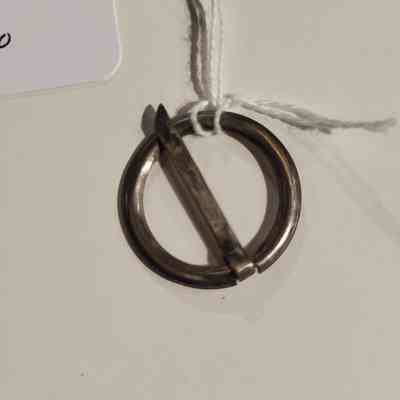
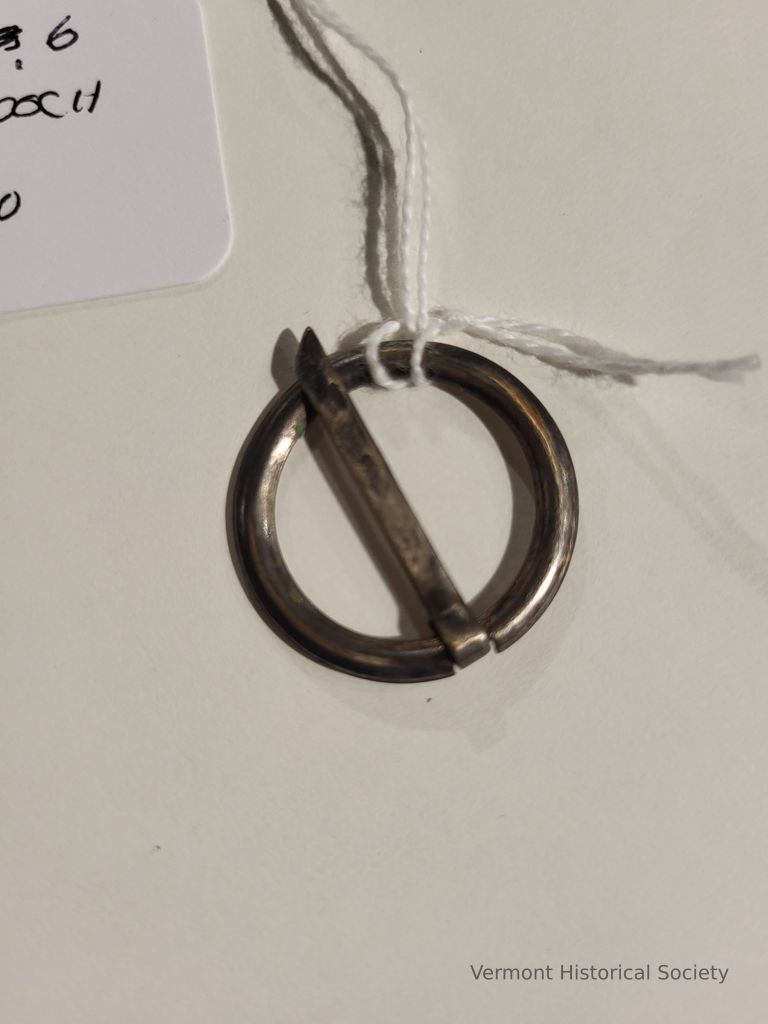
Ring Brooch
Name/Title
Ring Brooch
Item Type
Lexicon
Description
Ring brooch
Acquisition
Source (if not Accessioned)
Abenaki Cultural Conservancy
Made/Created
Date made
circa 1800
Materials
Material
Silver
Entry/Object ID
L2024.3.6
Context
Wiseman states: This brooch, along with L2024.3.4-5 and L2024.3.7-8, were found in a Riker mount in the group shop, with a Western NH provenance and an assurance that they were solid coin silver and old. They were in almost pristine condition without much if any crinkling of the central prong. I worry that they were good repros, but they are not embossed “India” like many modern reproductions. They were full price, so I bought them for the provenance, but am unsure of their age, since trade silver is not my specialty.
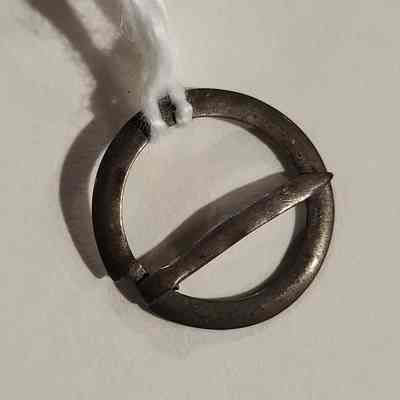

Ring Brooch
Name/Title
Ring Brooch
Item Type
Lexicon
Description
Small ring brooch
Acquisition
Source (if not Accessioned)
Abenaki Cultural Conservancy
Made/Created
Date made
circa 1800
Materials
Material
Silver
Entry/Object ID
L2024.3.3
Context
Wiseman states: as far as I know these three tiny, stamped ring brooches have not been reproduced for the reenactor trade. I purchased them from a reputable dealer who said in post purchased correspondence that they had a Salmon (Falls) River Valley (Border of Maine and NH) provenance and were found with some other 18th century personal items in an old house but would not give me the village they came from. They are in almost pristine condition.
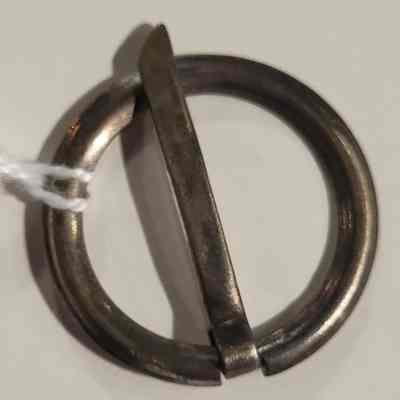
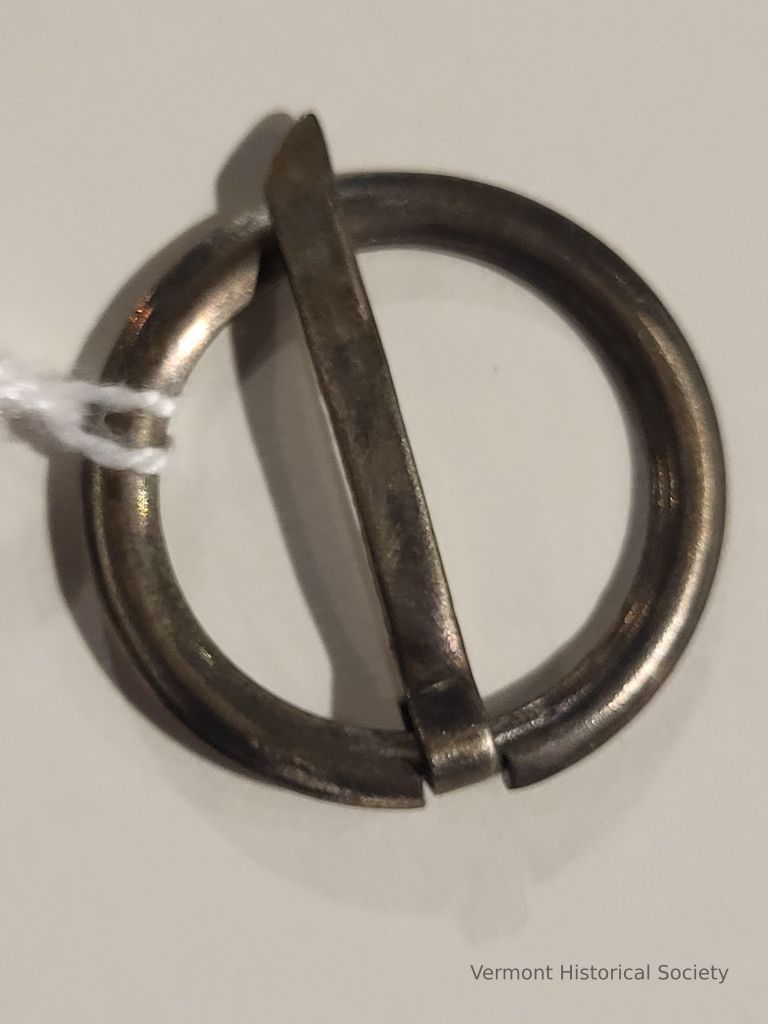
Ring Brooch
Name/Title
Ring Brooch
Item Type
Lexicon
Description
Ring brooch
Acquisition
Source (if not Accessioned)
Abenaki Cultural Conservancy
Made/Created
Date made
circa 1800
Materials
Material
Silver
Entry/Object ID
L2024.3.7
Context
Wiseman states: This brooch, along with L2024.3.4-6 and L2024.3.8, were found in a Riker mount in the group shop, with a Western NH provenance and an assurance that they were solid coin silver and old. They were in almost pristine condition without much if any crinkling of the central prong. I worry that they were good repros, but they are not embossed “India” like many modern reproductions. They were full price, so I bought them for the provenance, but am unsure of their age, since trade silver is not my specialty.
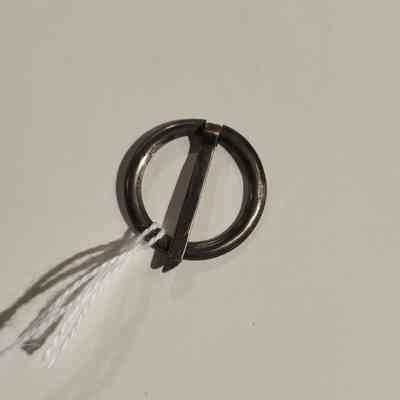

Ring Brooch
Name/Title
Ring Brooch
Item Type
Lexicon
Description
Ring brooch
Acquisition
Source (if not Accessioned)
Abenaki Cultural Conservancy
Made/Created
Date made
circa 1800
Materials
Material
Silver
Entry/Object ID
L2024.3.8
Context
Wiseman states: This brooch, along with L2024.3.4-7, were found in a Riker mount in the group shop, with a Western NH provenance and an assurance that they were solid coin silver and old. They were in almost pristine condition without much if any crinkling of the central prong. I worry that they were good repros, but they are not embossed “India” like many modern reproductions. They were full price, so I bought them for the provenance, but am unsure of their age, since trade silver is not my specialty.
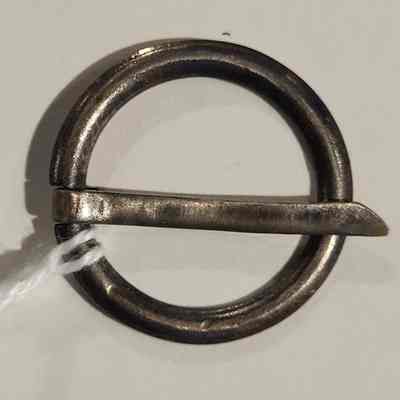
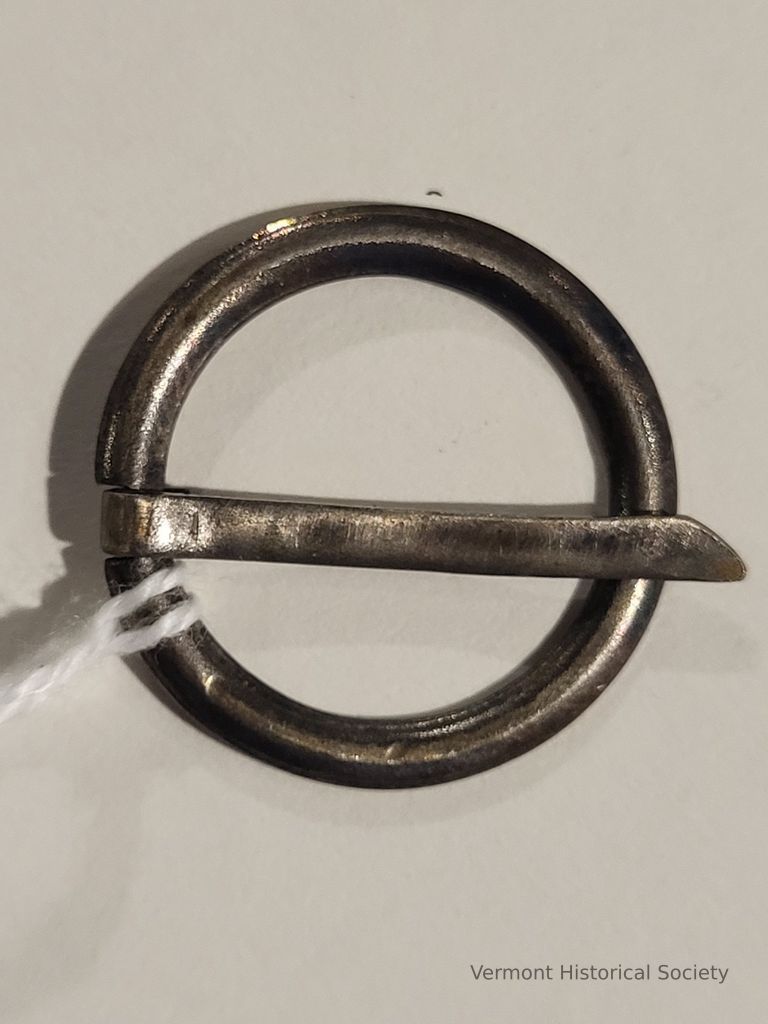
Ring Brooch
Name/Title
Ring Brooch
Item Type
Lexicon
Description
Ring brooch
Acquisition
Source (if not Accessioned)
Abenaki Cultural Conservancy
Made/Created
Date made
circa 1800
Materials
Material
Silver
Entry/Object ID
L2024.3.4
Context
Wiseman states: This brooch, along with L2024.3.5-8, were found in a Riker mount in the group shop, with a Western NH provenance and an assurance that they were solid coin silver and old. They were in almost pristine condition without much if any crinkling of the central prong. I worry that they were good repros, but they are not embossed “India” like many modern reproductions. They were full price, so I bought them for the provenance, but am unsure of their age, since trade silver is not my specialty.